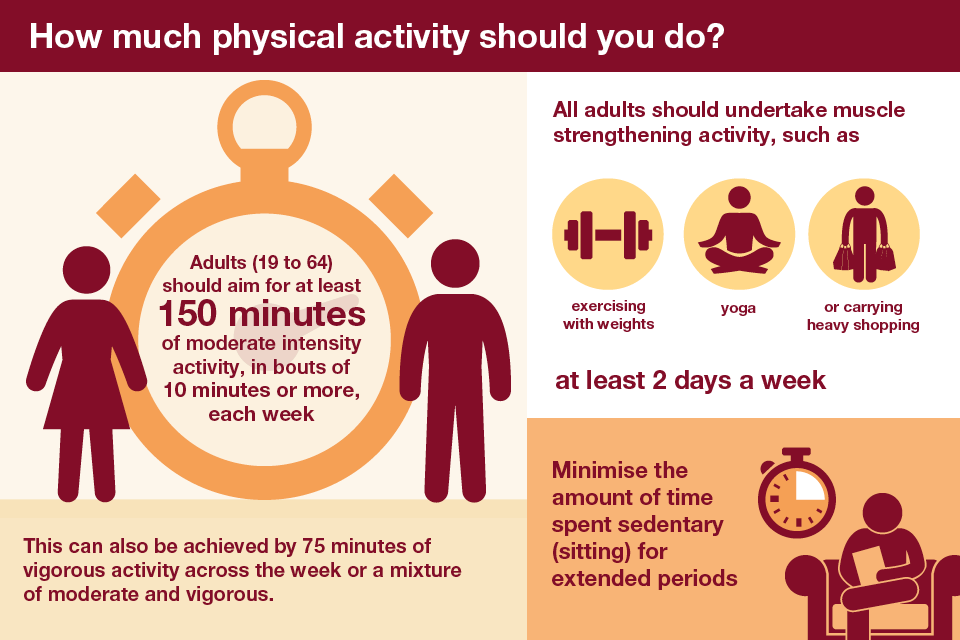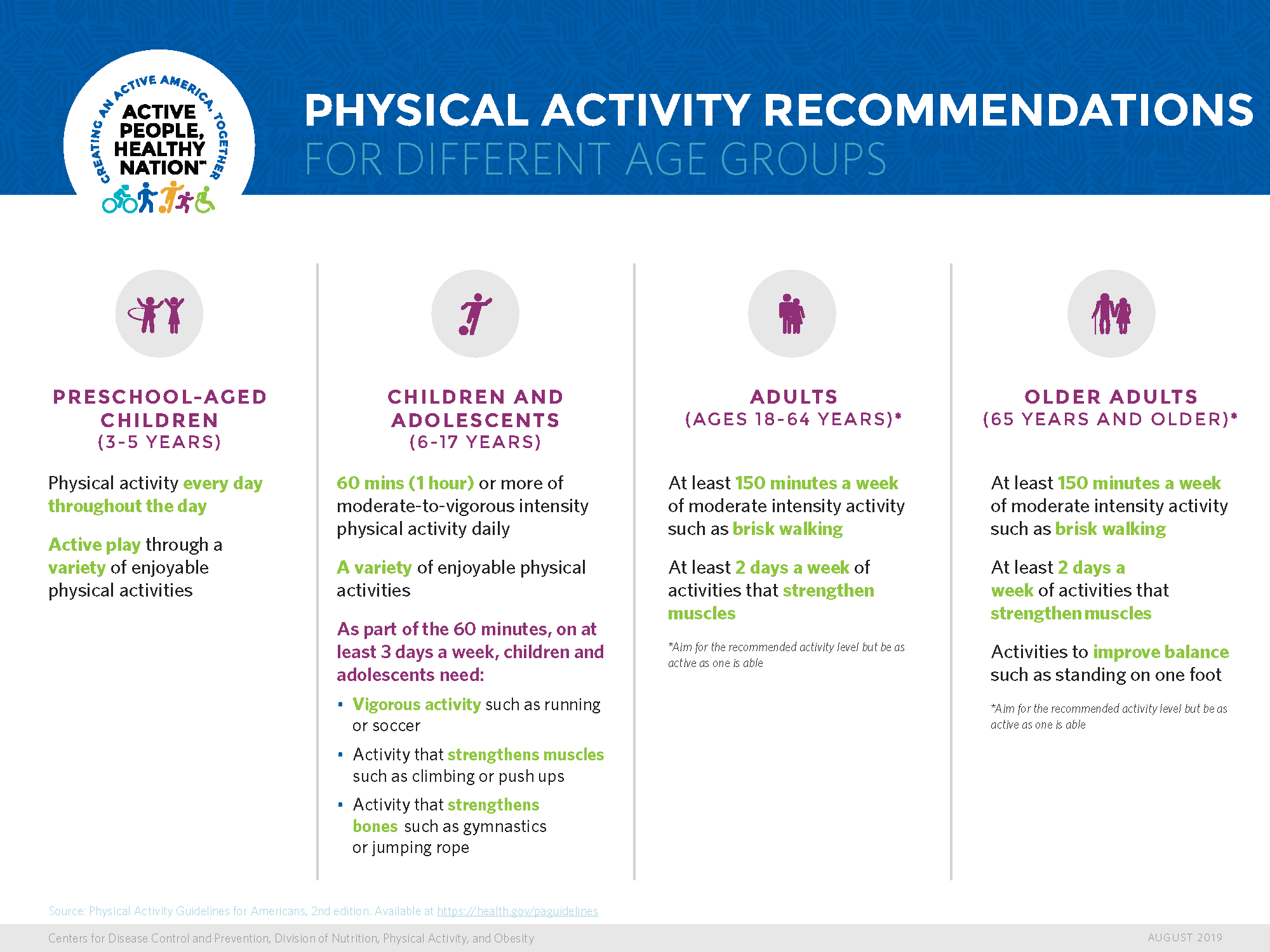Physical Activity Recommendations for Adults are crucial for a healthy and fulfilling life. Regular physical activity is not just about looking good; it’s about feeling good, improving your health, and increasing your lifespan. The benefits of regular exercise are vast, encompassing everything from reduced risk of chronic diseases like heart disease, stroke, and type 2 diabetes to enhanced mental well-being, improved sleep quality, and even boosted energy levels.
The World Health Organization (WHO) and the American Heart Association (AHA) recommend a minimum of 150 minutes of moderate-intensity aerobic activity or 75 minutes of vigorous-intensity aerobic activity per week, along with muscle-strengthening activities at least twice a week.
This article will delve into the details of these recommendations, explore the benefits of different types of physical activity, and provide practical tips for incorporating exercise into your daily routine. We’ll also discuss how to overcome common barriers to physical activity and how to stay motivated on your fitness journey.
Whether you’re a seasoned athlete or just starting out, this guide will provide valuable insights to help you achieve your health and fitness goals.
The Importance of Physical Activity for Adults
Regular physical activity is crucial for maintaining good health and well-being throughout adulthood. It offers numerous benefits, ranging from reducing the risk of chronic diseases to improving mental health and increasing lifespan.
Reduced Risk of Chronic Diseases
Physical activity plays a significant role in preventing chronic diseases, which are the leading causes of death and disability worldwide. Regular exercise can lower the risk of developing conditions such as heart disease, stroke, type 2 diabetes, certain types of cancer, and osteoporosis.
According to the World Health Organization (WHO), physical inactivity is a leading risk factor for non-communicable diseases, contributing to approximately 3.2 million deaths globally each year.
The Centers for Disease Control and Prevention recommends at least 150 minutes of moderate-intensity aerobic activity or 75 minutes of vigorous-intensity aerobic activity per week for adults. Maintaining a healthy lifestyle includes not only exercise but also financial planning, like securing the right home insurance.
For Rhode Island residents, a comprehensive guide to securing affordable and reliable home insurance can be found at Rhode Island Home Insurance Quotes: A Guide for Homeowners. After securing your home’s financial well-being, focus on your own well-being by incorporating regular physical activity into your routine.
Improved Mental Health
Physical activity has been shown to have a positive impact on mental health, reducing symptoms of anxiety, depression, and stress. It releases endorphins, which have mood-boosting effects, and helps to improve sleep quality, which is essential for mental well-being.
The US Department of Health and Human Services recommends at least 150 minutes of moderate-intensity aerobic activity or 75 minutes of vigorous-intensity aerobic activity per week for adults. These guidelines can help you stay healthy and active, which can also reduce your insurance premiums.
To get a better understanding of how your lifestyle impacts your insurance costs, check out Get a USAA Insurance Quote: A Comprehensive Guide , where you can explore personalized insurance options and discover how your healthy habits can save you money.
By taking care of your health and making informed insurance decisions, you can secure a brighter future for yourself and your loved ones.
A study published in the Journal of Psychiatric Research found that regular physical activity was associated with a lower risk of developing depression.
Increased Lifespan
Studies have consistently demonstrated that physically active individuals tend to live longer and healthier lives compared to their sedentary counterparts. Regular exercise strengthens the cardiovascular system, improves muscle function, and enhances overall health, leading to a reduced risk of premature death.
A meta-analysis of 14 studies involving over 1 million participants found that individuals who engaged in at least 150 minutes of moderate-intensity physical activity per week had a 20% lower risk of premature death.
The US Department of Health and Human Services recommends at least 150 minutes of moderate-intensity aerobic activity or 75 minutes of vigorous-intensity aerobic activity per week for adults. For those who enjoy time on the water, staying active might involve boating, and USAA offers competitive rates for military members seeking boat insurance.
Regardless of the chosen activity, finding ways to incorporate movement into daily life is crucial for maintaining physical and mental well-being.
Current Physical Activity Recommendations: Physical Activity Recommendations For Adults

Staying physically active is essential for overall health and well-being, particularly for adults. Reputable organizations like the World Health Organization (WHO) and the American Heart Association (AHA) have established comprehensive guidelines to promote healthy physical activity habits.
Physical Activity Recommendations for Adults
These recommendations provide a framework for individuals to achieve the desired health benefits from physical activity. The guidelines generally recommend at least 150 minutes of moderate-intensity aerobic activity or 75 minutes of vigorous-intensity aerobic activity per week, or a combination of both.
It’s also recommended to engage in muscle-strengthening activities at least two days a week.
Types of Physical Activity
There are three main types of physical activity that contribute to overall fitness and health:
Aerobic Activity
Aerobic activity, also known as cardio, is any activity that raises your heart rate and breathing. Examples include:
- Brisk walking
- Running
- Swimming
- Cycling
- Dancing
Strength Training
Strength training involves exercises that use resistance to build and maintain muscle mass. Examples include:
- Weightlifting
- Bodyweight exercises (push-ups, squats, lunges)
- Resistance band exercises
Flexibility Exercises
Flexibility exercises help improve range of motion and reduce the risk of injury. Examples include:
- Stretching
- Yoga
- Tai chi
Physical Activity Recommendations in a Table, Physical Activity Recommendations for Adults
The following table summarizes the current physical activity recommendations for adults:
| Activity Type | Frequency | Duration | Intensity |
|---|---|---|---|
| Aerobic | At least 150 minutes per week | 30 minutes per day, 5 days a week | Moderate intensity (enough to break a sweat) |
| Aerobic | At least 75 minutes per week | 15 minutes per day, 5 days a week | Vigorous intensity (breathing hard and unable to talk easily) |
| Strength Training | At least 2 days per week | 2-3 sets of 8-12 repetitions | Moderate intensity (feeling a challenge) |
| Flexibility | At least 2-3 days per week | Hold each stretch for 10-30 seconds | Gentle stretching to the point of mild discomfort |
Benefits of Different Types of Physical Activity

Regular physical activity offers a wide range of health benefits for adults. Engaging in different types of exercise can target specific areas of the body and address various health concerns. Understanding the benefits of each type can help you make informed choices about your exercise routine and achieve your fitness goals.
Aerobic Exercise
Aerobic exercise, also known as cardio, is any activity that raises your heart rate and breathing for a sustained period. It is crucial for cardiovascular health, improving heart function, blood pressure, and cholesterol levels. Examples of aerobic exercises include:
- Running
- Swimming
- Cycling
- Dancing
- Jumping rope
Aerobic exercise also plays a vital role in weight management by burning calories and increasing metabolism.
Strength Training
Strength training involves exercises that use resistance to build muscle mass and improve bone density. It is essential for maintaining strength, balance, and mobility as we age. Examples of strength training exercises include:
- Weightlifting
- Bodyweight exercises (push-ups, squats, lunges)
- Resistance band exercises
Strength training also helps prevent injuries, improves posture, and enhances overall physical function.
Flexibility Exercises
Flexibility exercises, such as stretching, yoga, and Pilates, improve range of motion, reduce muscle stiffness, and increase flexibility. This can help prevent injuries, improve balance, and enhance overall well-being.
Benefits Comparison
| Type of Exercise | Benefits |
|---|---|
| Aerobic Exercise | Improves cardiovascular health, weight management, and overall fitness |
| Strength Training | Builds muscle mass, improves bone density, and enhances strength and mobility |
| Flexibility Exercises | Improves range of motion, reduces muscle stiffness, and enhances balance |
Tips for Incorporating Physical Activity into Daily Life
It’s easy to get caught up in the hustle and bustle of daily life, making it challenging to prioritize physical activity. But incorporating movement into your routine doesn’t have to be a monumental task. With a little planning and creativity, you can make exercise a regular part of your day, reaping the many benefits it offers.
Finding Time for Physical Activity
Finding time for physical activity can seem daunting, especially when you’re juggling work, family, and other commitments. But remember, even small amounts of activity can make a difference.
- Schedule it in:Treat exercise like any other important appointment. Block out time in your calendar, even if it’s just 15-20 minutes at a time.
- Make it convenient:Choose activities that are easy to fit into your day, like walking or jogging during your lunch break, taking the stairs instead of the elevator, or doing a quick workout at home.
- Combine it with other activities:Turn errands into exercise opportunities by walking or biking to the grocery store or park.
- Multitask:Listen to a podcast or audiobook while walking or jogging. This can help pass the time and make your workout more enjoyable.
Overcoming Barriers to Physical Activity
Life can throw curveballs, making it challenging to stick to your fitness goals. But there are strategies to overcome these barriers:
- Identify your obstacles:Do you struggle with lack of time, motivation, or access to facilities? Understanding your specific barriers is the first step to overcoming them.
- Find solutions:Once you know what’s holding you back, you can start brainstorming solutions. For example, if lack of time is an issue, try scheduling short workouts throughout the day.
- Be flexible:Life is unpredictable. If you can’t stick to your planned workout, don’t give up entirely. Do a shorter workout or choose a different activity that fits your schedule.
- Seek support:Enlist the help of friends, family, or a workout buddy. Having someone to support you can make it easier to stay motivated and accountable.
Making Physical Activity a Habit
Turning physical activity into a habit requires consistency and a bit of planning:
- Set realistic goals:Don’t try to do too much too soon. Start with small, achievable goals and gradually increase the intensity and duration of your workouts.
- Find enjoyable activities:Choose activities you genuinely enjoy. If you don’t like running, don’t force yourself to do it. There are many other ways to get a good workout.
- Reward yourself:Celebrate your successes. When you reach a milestone, reward yourself with something you enjoy, like a new workout outfit or a relaxing massage.
- Track your progress:Keep a journal or use a fitness tracker to monitor your activity levels. This can help you stay motivated and see how far you’ve come.
Small Changes for Big Results
You don’t need to overhaul your entire lifestyle to reap the benefits of physical activity. Even small changes can make a difference:
- Take the stairs:Instead of taking the elevator, choose the stairs whenever possible.
- Walk during your lunch break:Get up and move around instead of sitting at your desk.
- Park further away:When you’re running errands, park a little further away from your destination and walk the rest of the way.
- Stand up more often:Take frequent breaks from sitting and stand up or walk around.
Conclusive Thoughts

In conclusion, Physical Activity Recommendations for Adults are not merely guidelines; they are a roadmap to a healthier, happier, and more fulfilling life. By understanding the benefits of different types of physical activity and incorporating them into your daily routine, you can reap the rewards of a healthier body and mind.
Remember, it’s never too late to start, and even small changes can make a significant difference. So, take the first step, find an activity you enjoy, and start moving towards a healthier you!


